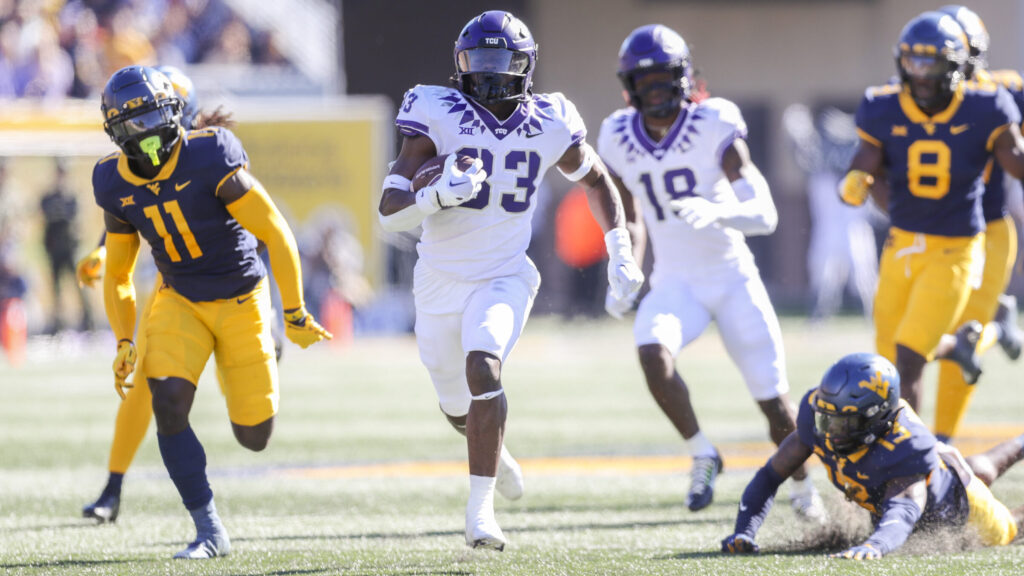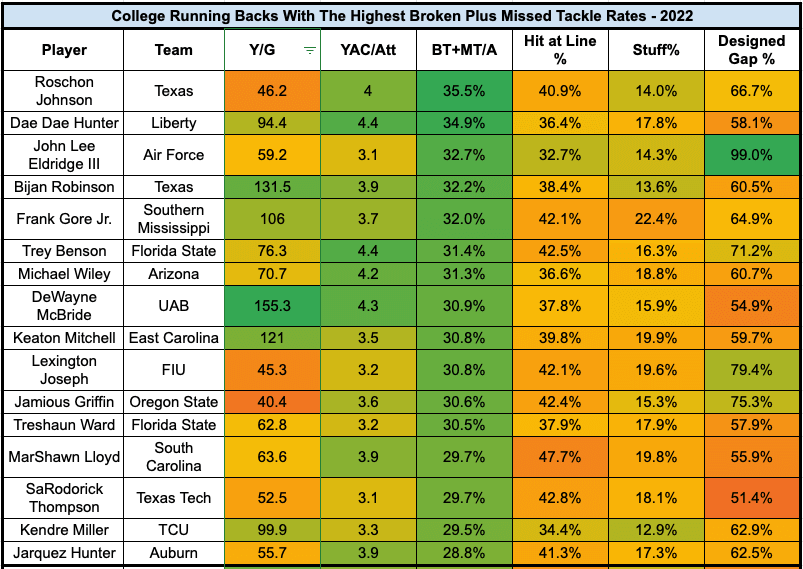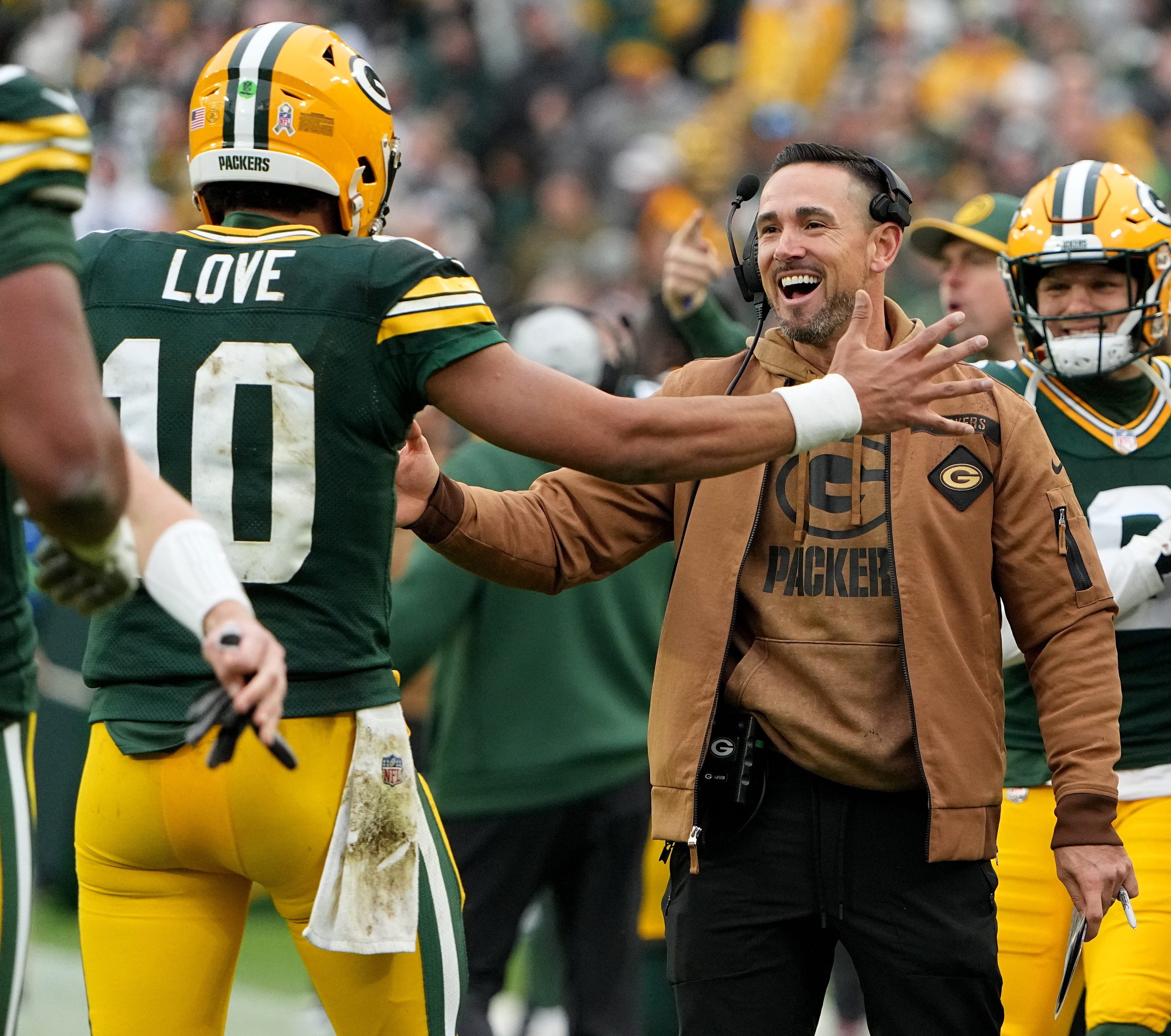Expert Analysis
3/25/23
8 min read
2023 NFL Draft: Round 3-4 Running Back Prospects Worth Monitoring

In this installment of our running back prospect profile series, we have a mixture of one-year wonders and backs with enticing metrics, though they come with red flags. While these running back prospects hold name value given their college journey and respective conferences, let's dig into the data as an early 2023 outlook.
How do these running back prospects compare to past players from a production standpoint? Do they have standout skills? We hope to answer those questions about four running backs with third- and fourth-round projected capital.
 Kendre Miller, RB, TCU
Kendre Miller, RB, TCU
Kendre Miller (scouting report) dominated last season with 224 carries, 1,399 yards rushing and 17 scores. That translated into a 39 percent RB dominator on a TCU squad, including Max Duggan and Quentin Johnston (scouting report). With Duggan's added rushing production, Miller only garnered a three percent receiving yardage market share. Based on his college production, Miller compares closely to Stevan Ridley, Hassan Haskins, Alexander Mattison and Bilal Powell.
The underlying metrics support Miller's college production, evidenced by his 3.3 yards after contact (No. 37) and 29.5 percent broken plus missed tackle rate (No. 15) among backs with 50 carries. Miller posted a quality stuff rate of 12.9 percent (No. 36 out of 200), meaning less than 13 percent of his carries went for zero or fewer yards. That further aligns with Miller's ability to fight for extra yards and not have defenders stop him in the backfield.
Miller's Early Outlook
With his projected NFL Draft capital in the fourth round, he compares to Darrynton Evans, Jonathan Williams, Ryquell Armstead and Zamir White. Unfortunately, Miller didn't participate in the NFL Combine workouts, so we don't have athleticism measures. He does have the size we look for at 5-foot-11, 215 pounds. Hopefully, he possesses a 40-yard dash speed of around 4.55 or lower. Miller checks the size, production and advanced metrics boxes, adding to the depth of the running back class. Landing spot matters, but maybe the unknown athletic measures keep his dynasty and redraft price depressed as a potential value selection.
 Tank Bigsby, RB, Auburn
Tank Bigsby, RB, Auburn
While it looks like Tank Bigsby (scouting report) took a step back in rushing production, he made up for it in the receiving game with a nine percent receiving yardage market share. That increased from six percent in 2021, a respectable number similar to Zach Charbonnet (scouting report) and Chase Brown (scouting report) in the 2023 class. Bigsby's 41 percent RB dominator ranks in the bottom half of the class when including some of their best seasons in the small sample.
Based on Bigsby's college production, he compares closely to several fun names, including Javonte Williams, Cam Akers, Travis Etienne, Jahvid Best and Mark Ingram. Unfortunately, Bigsby likely won't match them in draft capital. All of those players were first-rounders outside of Williams at pick 35 and Akers at 52. Bigsby projects as a third-round pick, so there's a tiny chance his stock improves as we move closer to the draft. He didn't elevate his draft stock at the combine with a 44th-percentile Speed Score and 55th-percentile Freak Score.
Bigsby's Advanced Metrics
Bigsby ranked highly in the advanced metrics, evidenced by the 28th-best YAC/Att (3.5) and 34th-highest BT+MT/Att (24.2 percent). It's probably related to team context, but defenders hit Bigsby at the line 47.8 percent of the time (12th-highest). That's a concerning metric.
He's either running into defenders or being met with contact quite often. Though Bigsby breaks and misses tackles at a high rate, 24.2 percent of his carries resulted in zero or fewer yards. That's the 14th-highest stuff rate, which isn't positive, yet Bigsby has the YAC profile.
On the receiving end, the metrics give us pause. Bigsby had the 15th-most targets (46) among running backs but 1.1 yards per route run (No. 131 out of 200). He also wasn't efficient on a per-target basis, with 3.9 yards per target (No. 180), though he averaged a -1.5 aDOT (No. 168). These metrics don't fully define Bigsby, as we've seen many pass-catching running backs add value as a receiver without the efficiency.
Bigsby's Early Outlook
When we add Bigsby's weight and speed, his comps don't look as friendly as Etienne or Akers, as noted earlier. It changes to Isaiah Spiller, Marlon Mack, Paul Perkins, and Kenneth Dixon. All these backs had sleeper buzz at one point, so maybe Bigsby will deliver as a 2023 running back prospect. Given the depth of the class, Evan Hull and other flashier backs might warrant more intrigue unless Bigsby lands in a fantasy-friendly situation.
Zach Evans, RB, Ole Miss
Zach Evans (scouting report) played at TCU for two seasons, then went to Ole Miss. At TCU, Evans shared the backfield with Emari Demercado and Kendre Miller, and then Miller popped off as a junior to lead the TCU backfield. Evans couldn't beat out a true freshman Quinshon Judkins, who might be one of the best running back prospects in the future. In Evans' final year in college, he peaked at 936 rushing yards and nine rushing touchdowns, translating to a 36 percent RB Dominator. With Judkins dominating the running back touches (47 percent RB Dominator), Evans had a four percent receiving yardage market share.
As one would expect, the comparisons for Evans don't appear optimistic, with Zonovan Knight as the most notable player. Knight was an undrafted free agent, with Evans having projected capital in the third round. Based on Evans' size at 202 pounds and third-round capital, the comps look better, including Devonta Freeman, Anthony McFarland, and Joe McKnight. Unfortunately we don't have a 40-yard dash time, as that would change if Evans ranked highly in the athleticism measures.
Evans' Advanced Metrics
Though the college production hasn't been great, Evans flashed above-average advanced metrics. He ranked 28th with a 3.5 YAC/Att and 35th in BT+MT/Att (24.1 percent). That's similar to Bigsby and Charbonnet, though Evans sits in between the two via stuff rate. Just under 16 percent of Evans' rushing attempts went for zero or fewer yards, which ranked above the median at No. 92. For fun, we'll compare Evans to Judkins, who averaged 3.2 YAC/Att, a 22.3 percent BT+MT/Att and a 20.5 percent stuff rate.
Evans' Early Outlook
On the surface, the lack of college production raised red flags, especially when considering a true freshman outperformed him at Ole Miss. Assuming Evans maintains a third-round draft capital, it should give him an opportunity to contribute early on as a rookie. If we projected a 40-yard time similar to Devonta Freeman in the 4.5s, that would give him an above-average speed score. Given the ability to break and evade tacklers, Evans probably possesses the agility to do the same in the NFL. The underlying metrics alone should warrant the intrigue to buy into Evans as an undervalued running back prospect.
[bc_video video_id="6319426323112" account_id="6312875271001" player_id="default" embed="in-page" padding_top="56%" autoplay="" min_width="0px" playsinline="playsinline" picture_in_picture="" language_detection="" application_id="" max_width="680px" mute="muted" width="100%" height="100%" aspect_ratio="16:9" sizing="responsive" ]
Eric Gray, RB, Oklahoma
After two seasons at Tennessee, Eric Gray (scouting report) left for Oklahoma, where he played behind Kennedy Brooks in 2021. In a shared role, Gray posted a 56 percent RB Dominator as a freshman and 69 percent as a sophomore. Brooks went undrafted last season and shifted to the Philadelphia Eagles' practice squad before being released in November. While we've witnessed many UDFA running backs outperforming expectations, Brooks' path is far too common.
We note that because Gray projects for fourth-round draft capital, that makes us feel better about his chances of sticking around in the NFL. Gray peaked as a senior with 1,364 yards rushing and 11 rushing scores, turning into a 46 percent RB Dominator. Sneakily, Gray chipped in via the receiving game, with a career seven percent receiving yardage market share. Gray had 99 career receptions, tying him with Christian McCaffrey, Demetric Felton, and Dri Archer since 2010. That should help Gray earn a pass-catching role with a diverse skillset at the pro level.
Gray's Underlying Metrics
He tied with Mohamed Ibrahim (scouting report) with 3.1 YAC/Att (No. 57), plus a quality 23.5 percent BT+MT/Att (No. 45). Gray also used his designed gaps 71.4 percent of the time (No. 48), with a healthy 12.7 percent stuff rate (No. 34). That indicates Gray showed the ability to use his run blockers effectively or display the vision to find the open gaps.
The table above shows the top running back prospects in the receiving metrics from the 2023 class. Amongst running backs with ten targets, Gray garnered 43 opportunities, with 1.7 YPRR and 5.3 YPT. We'll see how that translates to the NFL since the Oklahoma offense circled around Gray and Marvin Mims in 2022.
Gray's Early Outlook
As one of the oldest running backs in the 2023 class, Gray's age might cause fantasy managers to shy away. It's usually a smart process to avoid aging running back prospects, but Gray still could have two to three years of viability based on the landing spot. When adding the fourth-round draft capital, Gray's closest comparisons include DeAndre Washington, Michael Carter, James White, and Mike Davis. Those comps would be safe expectations, as running back prospects with the receiving skills to solidify themselves in a part-time role. While some running back prospects lack the receiving element, it gives us confidence in Gray finding fantasy relevance early in his career.














